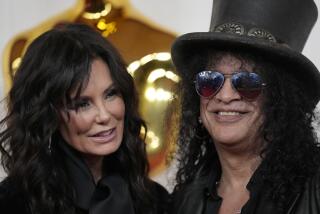OBITUARIES : Sir Frederick Ashton, 83; Longtime Choreographer for the Royal Ballet
Sir Frederick Ashton, the urbane, distinctive choreographer who had come to be regarded as one of England’s national treasures, has died in his sleep, it was reported Friday.
A spokesman for the Royal Opera House, Covent Garden, parent of the Royal Ballet, said the regal Sir Frederick, a close friend and frequent escort of the Queen Mother, died Thursday night at his country house in Eye, in the Suffolk area, northeast of London. He was 83.
“Nobody could create a more touchingly tender love duet than he,” said a press release issued by the Royal Ballet, where he worked for more than three decades, including seven years as director.
‘Something Shakespearean’
“But there (also) is something Shakespearean about the way he could move within a single work from sweet lyricism to knock-about comedy or delicately barbed wit,” it said.
Long considered the most important influence in British dance, Sir Frederick--knighted in 1962--had created more than 100 works for the old Vic-Wells ballet, which evolved into Sadler’s Wells and the Royal Ballet, where he was director from 1963 to 1970. He had been the company’s chief choreographer since the mid-1930s.
His creations ranged from the ballet-comedy “A Wedding Bouquet” to “Cinderella” in 1948, the first three-act ballet created for a British company. He also created dances for operas, films, musical comedies and revues and nearly all of ballerina Dame Margot Fonteyn’s triumphs.
The most successful of his works are considered “Facade” in 1931; “Les Patineurs” in 1937; “La Fille Mal Gardee” in 1960 and “Jazz Calendar” in 1968. Balletomanes rank his two “Monotones” and “Symphonic Variations” among the best of his abstractions.
Others of his better-known ballets include “Romeo and Juliet,” “Ondine,” “Marguerite and Armand” and “Daphnis and Chloe.”
Never Planned Steps
“I never knew what the steps were going to be before I entered the rehearsal room,” Sir Frederick said in a 1987 interview with The Times, one granted in connection with the staging of several of his works by the Joffrey Ballet during its Los Angeles season.
“But I did know exactly who would be doing what at each moment in the music. . . . The music . . . tells you what should happen and once you’ve plotted out the story and the music, side by side, then the steps will come very quickly and, one hopes, very naturally.”
Frederick William Mallandaine Ashton was born in Guayaquil, Ecuador, to an English diplomatic official and his wife and was sent at a young age to Lima, Peru, where he was educated by Dominican fathers. After seeing Anna Pavlova perform in Lima in 1917, he fell in love with ballet and wanted to become a dancer.
His family objected and he was forced to complete his schooling before starting a stage career.
He studied with Marie Rambert and Leonide Massine, neither of whom were true classical dancers, so he was forced to invent his own classicism.
“It’s like being born French or Portuguese, he said last year of his bent toward traditional ballet. “It’s my language and that’s what I speak.”
Encouraged to Choreograph
Rambert was the teacher who encouraged him to pursue choreography rather than performance and his first commission was for a small ballet called “A Tragedy of Fashion” or “The Scarlet Scissors.” It was created for a 1926 revue “Riverside Nights.”
He continued to perform, primarily in Europe for a year with the Ida Rubenstein Ballet, and in 1931 did his first work for Ninette de Valois, beginning a longtime working relationship with her and the company she fostered, which grew into the Royal Ballet.
They drew inspiration from English painters and music for a style marked by “poise, purity, (and) freshness,” the Royal Ballet statement said.
Sir Frederick noted sadly last year that of the four choreographers born in 1904 (George Balanchine, Anton Dolin, Serge Lifar and himself) he was the only one left. He also said he considered the dancers of that distant era superior to their modern-day counterparts.
“I think we were all better artists. . . . Because our techniques weren’t (as good) as they are today we had to exercise ourselves more to make an impact.
“I think we performed better. . . . I mean, we weren’t so interested in getting our legs up behind our ears, or anything of that sort,” he said, adding that today’s choreographers seem to score for technique for its own sake rather than for pure expression.
Several Honors
In addition to his knighthood, Sir Frederick, who never married, was awarded a Companion of Honor in 1970, the Order of Merit in 1977 and admission to the French Legion of Honor in 1962.
However, he was not without his critics. His blending of pure and lyrical dance, much of it based on folkloric themes, sometimes produced charges of artificiality.
“I’m very aware of being over-pretty,” he would reply. I watch myself.”
Sir Frederick was still creating dances and generating applause as recently as June, staging an adaptation of Shakespeare’s “A Midsummer Night’s Dream” at a gala performance in honor of his former mentor, now Dame Ninette, British ballet’s 90-year-old grande dame.
On Friday she said of Sir Frederick: “He would draw something out of an artist that they did not know they possessed, he gave them confidence and a sense of awareness that otherwise would have been lost.
“It is the duty of the Royal Ballet to preserve his works, for herein lies all that he gave to the national ballet of his country--forever and a day.”
Martin Bernheimer, The Times’ music and dance critic, found “Ashton a man of wit, taste and elegant invention. His work reflected a rare sense of proportion, a keen sensitivity to matters of style and mood, a romantic spirit informed by classical restraint. As director of the Royal Ballet, he enhanced a noble tradition, enriching the repertory, improving technical standards and bringing special refinement to the corps de ballet .”
More to Read
The biggest entertainment stories
Get our big stories about Hollywood, film, television, music, arts, culture and more right in your inbox as soon as they publish.
You may occasionally receive promotional content from the Los Angeles Times.






